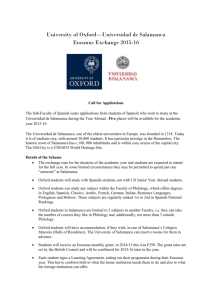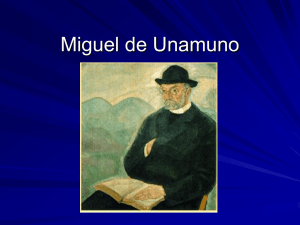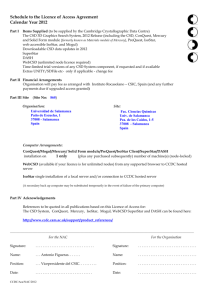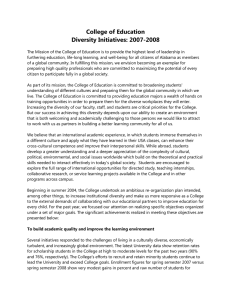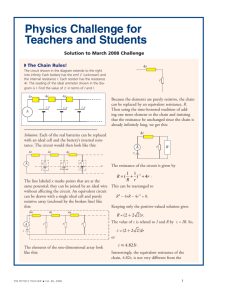S , S : C M
advertisement
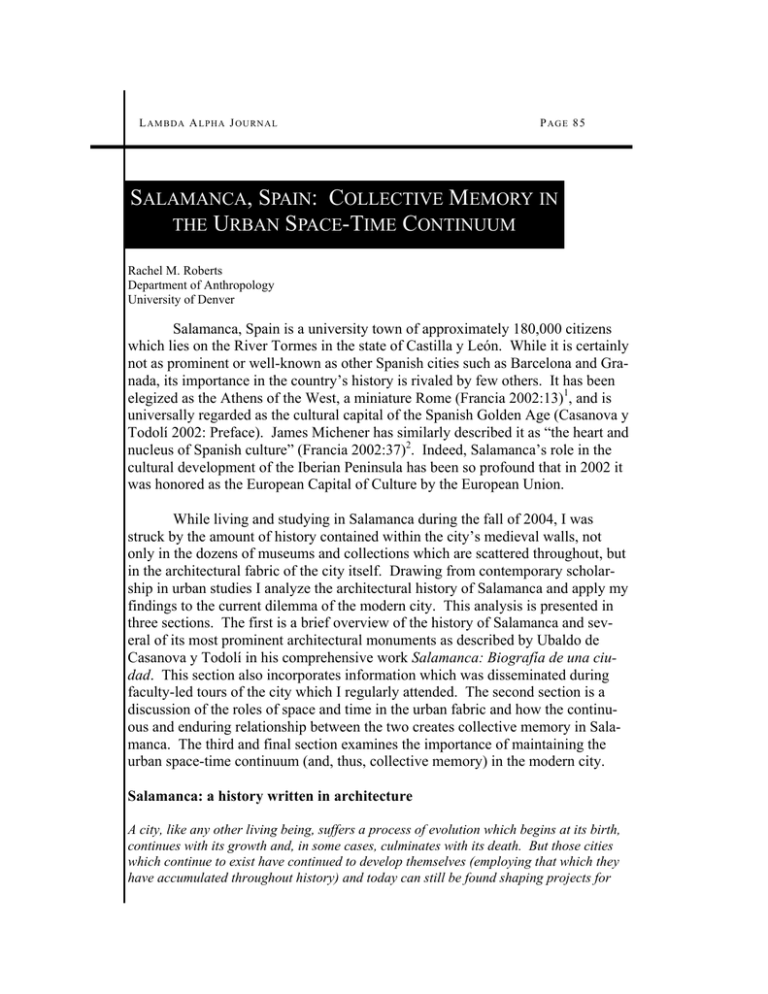
L A M B DA A LPH A J O U RN A L PAGE 85 SALAMANCA, SPAIN: COLLECTIVE MEMORY IN THE URBAN SPACE-TIME CONTINUUM Rachel M. Roberts Department of Anthropology University of Denver Salamanca, Spain is a university town of approximately 180,000 citizens which lies on the River Tormes in the state of Castilla y León. While it is certainly not as prominent or well-known as other Spanish cities such as Barcelona and Granada, its importance in the country’s history is rivaled by few others. It has been elegized as the Athens of the West, a miniature Rome (Francia 2002:13)1, and is universally regarded as the cultural capital of the Spanish Golden Age (Casanova y Todolí 2002: Preface). James Michener has similarly described it as “the heart and nucleus of Spanish culture” (Francia 2002:37)2. Indeed, Salamanca’s role in the cultural development of the Iberian Peninsula has been so profound that in 2002 it was honored as the European Capital of Culture by the European Union. While living and studying in Salamanca during the fall of 2004, I was struck by the amount of history contained within the city’s medieval walls, not only in the dozens of museums and collections which are scattered throughout, but in the architectural fabric of the city itself. Drawing from contemporary scholarship in urban studies I analyze the architectural history of Salamanca and apply my findings to the current dilemma of the modern city. This analysis is presented in three sections. The first is a brief overview of the history of Salamanca and several of its most prominent architectural monuments as described by Ubaldo de Casanova y Todolí in his comprehensive work Salamanca: Biografía de una ciudad. This section also incorporates information which was disseminated during faculty-led tours of the city which I regularly attended. The second section is a discussion of the roles of space and time in the urban fabric and how the continuous and enduring relationship between the two creates collective memory in Salamanca. The third and final section examines the importance of maintaining the urban space-time continuum (and, thus, collective memory) in the modern city. Salamanca: a history written in architecture A city, like any other living being, suffers a process of evolution which begins at its birth, continues with its growth and, in some cases, culminates with its death. But those cities which continue to exist have continued to develop themselves (employing that which they have accumulated throughout history) and today can still be found shaping projects for PAGE 86 V O LU M E 3 6 , 2 0 0 6 their future. In this way, each city has created its own personality which has allowed it to distinguish itself from all other cities. And this is what has happened with Salamanca. -Ubaldo de Casanova y Todolí (2002: Preface)3 Although archaeological evidence has shown that what is today the city of Salamanca was inhabited from as early as the seventh century BCE (Casanova y Todolí 2002:23), the history of the city with which we are concerned (that is the history which has manifested itself in the urban geography) begins in 220 BCE with the arrival of the Carthaginian conqueror Hannibal (25). The Carthaginian occupation had only lasted a few years when Roman forces took the city during the Second Punic War (218-202 BCE). Salamanca soon became an important waypoint on the Via de la Plata (the north-south route along which silver from the southern colony of Mérida was transported) and in the year 89 CE the Romans erected a stone bridge over the River Tormes in order to accommodate traders arriving from the south (27). The Roman Bridge’s endurance as a symbol of Salamanca is evidenced by its representation in the city’s heraldic crest. With the fall of the Roman Empire in the fifth century CE, Salamanca went through a tumultuous period of alternating Christian, Visigoth and Moorish occupations (30-33). After nearly three centuries of political upheaval, Salamanca had experienced a severe decrease in population and in 1102 Alfonso VI entrusted the Count of Borgoña to repopulate the city (37). In order to accommodate the new citizenry (as well as to continue attracting new inhabitants) a Romanesque cathedral was built between 1140 and 1220 (39). Known as the la Catedral Vieja, its bell tower (la Torre del Gallo) remains the tallest and most prominent figure on the urban skyline today. In 1492, Isabel of Castile and Ferdinand of Aragon (known collectively throughout Spain as los Reyes Católicos) wrested Granada from Muslim control and united the Iberian Peninsula. This unification coincided with an explosion of nationalistic Gothic architecture in Salamanca. A year after the fall of Granada, construction began on la Casa de las Conchas, a private residence in the Isabeline Gothic style, appropriately named after the Queen. The hundreds of scallop shells which adorn the exterior of the building identify its residents as members of the noble Order of Saint James and the prominent display of the royal crest of los Reyes Católicos above the main entrance demonstrates their allegiance to the new monarchs (94). The Plateresque style which is peculiar to Salamanca emerged shortly after in the early sixteenth century. Characterized by intricate details, deep relief and a profound sense of horror vacui, the Plateresque was made possible in Salamanca because of the city’s access to la piedra de Villamayor, a unique stone which when L A M B DA A LPH A J O U RN A L PAGE 87 first extracted from the quarry is highly malleable but which hardens with continued exposure to air and sunlight (184). La piedra de Villamayor is also significant to the architectural history of Salamanca because of its golden color which has earned the city the endearing nickname la Dorada (the Golden One). The façade of the University of Salamanca is the ultimate expression of the Plateresque style. Constructed in 1529, the façade embodies the transition from Gothic to Renaissance. In addition to paying homage to the monarchy and the papacy, the façade depicts a humanistic allegory of good and evil for all of its students to see. A tiny frog which sits atop a skull (and which was originally intended to warn male students of the seductive and sinful nature of women) has become a popular symbol of the city for it is said that finding the small amphibian amidst the dense ornamentation of the façade will bring students good luck on their final exams. As the reputation and the student body of the University continued to grow, so did Salamanca. The nave of la Catedral Vieja could no longer accommodate the growing citizenry, but rather than demolish the old cathedral and build a larger one in its stead, the city decided to build a new cathedral and attach it to the old one (114). La Catedral Nueva began construction in 1513 and was one of the last Gothic cathedrals to be constructed in all of Europe (115). On November 1, 1755, twenty-two years after the cathedral’s completion, the aftershocks of the Lisbon Earthquake were felt in Salamanca. To make sure that the integrity of the combined Romanesque-Gothic cathedral had not been compromised, the folk hero el Mariquelo climbed to the top of la Torre del Gallo to measure the angle of the tower. His legendary ascension is reenacted every November 1 to the delight of tourists and citizens alike. The seventeenth century saw the decline of the Spanish Empire and a renewed period of depopulation in Salamanca: the expulsion of Moorish and Portuguese families in 1609 and a catastrophic flood in 1626 decreased the citizenry from about 20,000 to approximately 16,350 (157). It is important to note that the flood also destroyed several important buildings in the neighborhoods closest to the River Tormes. In spite of (or, arguably, because of) these difficulties, Salamanca saw the rise of the Baroque style during this period. The rich ornamentation of La Clerecía, which began construction in 1617, was a visual symbol of the Catholic Church’s response to the Protestant Reformation. In 1700, Charles II, the last of the Hapsburg monarchs, died without an heir leading to the War of Succession (1700-1714). During the War, Salamanca supported the claim of the Bourbons to the throne and when they emerged victorious the city experienced a period of postwar prosperity. With this new wealth, the city leaders decided to build a central square where the sixteenth century Saint Mar- PAGE 88 V O LU M E 3 5 , 2 0 0 5 tin’s Market had been (177). Constructed between 1728 and 1755, la Plaza Mayor has endured as the center of public life in Salamanca: In the little over two centuries in which it has existed, la Plaza Mayor, a gift from the Bourbons to the city, has been a marketplace and agora, a revolving walkway in which gentlemen and ladies walk in opposite directions4, a wheel of leisure activity, an open square for bull fights and lively chess games alike, a rhetorical stage for political and poetic exaltations, a theatre and balcony, a seasonal solarium, a walkway for retired persons, a clock and multicenter (Aníbal Nuñez, quoted in Francia 2002:48.)5 During the Peninsular War (1808-1814), Spain was occupied by French forces and Joseph Bonaparte was installed as King of Spain (203). During the Battle of Salamanca in 1812, British and Portuguese forces emerged victorious against the French army, but not before French canon fire had severely damaged the historic neighborhood of los Caídos, which is still in the process of reconstruction today (204). The nineteenth century also saw the rise of the bourgeoisie, industrialization and urban sprawl in Salamanca. The creation of large urban parks such as la Parque de la Alamedilla during this period hints at the influence of the City Beautiful Movement (210). The twentieth century saw the introduction of modern architecture in Salamanca, the most prominent example of which is la Casa Lis of 1904, an Art Deco masterpiece with a striking stained glass façade which lies at the feet of the Cathedrals. The city’s architectural addendums have continued to evolve in style on into the twenty-first century, especially in the ever-expanding University campus. Perhaps the most interesting example of Post-Modern architecture in the city is el Palacio de Exposiciones y Congresos, a large, boxy building on the outskirts of the medieval city limits which serves various municipal functions. However, the fact that this building is one huge block of la piedra de Villamayor reflects the city’s attitude towards architectural innovation: The architectural tendency during the past few years has been centered on combining what has already been started with the monumental, creating an architecture with a modern air which is more in accordance with current tendencies. Insipid imitation and mimicry have predominated in a city which does not seem to wait for any other execution than that which is in strict harmony with its monumentality (Casanova y Todolí 2002:233-234.)6 Space, time and space-time: collective memory in the urban fabric The city is the result and expression of the historical space-time continuum by recording and assimilating the past into the present. -Milos Bobic (1990:27-29) L A M B DA A LPH A J O U RN A L PAGE 89 The collective memory needs to be anchored in visual monuments. -Diane Barthel (1996:154) Certainly the architectural fabric of the city comprises a visual historical text in Salamanca: the history of each successive age has been permanently etched into the urban landscape in the form of monumental edifices. But how does this monumental architecture create collective memory? To answer this question we must examine the two major components of memory (space and time) and how they work together to create unifying, continuous symbols. Space is the three-dimensional plane in which the physical structure of the city is realized. According to Eviatar Zerubavel, urban space (or place) is the foundation for collective memory: “Constancy of place is a formidable basis for establishing a strong sense of sameness…[our physical surroundings] constitute a reliable locus of memories and often serve as a major foci of personal as well as group nostalgia” (2003:41). Svetlana Boym agrees that place is important but suggests that it is not sufficient to create collective memory by itself: “Places are contexts for remembrances and debates about the future, not symbols of memory or nostalgia” (2001:77). According to Heidegger, time is the confirmation of human existence, the foundation of our sentient nature (Bobic 1990:4). Milos Bobic elaborates further on the importance of time referring to it as “an essential part of man’s search for his individual and social fate” as well as “the greatest universal value which enables control over all other values” (4). Because of its universal importance, Bobic concludes that “time generates the shape of individual and collective notions of the city” (9). Certainly space and time make important individual contributions to the creation of an urban environment which is conducive to collective memory, yet these two entities are inherently interdependent. Bobic asserts that “threedimensional space can neither be completely understood nor can it appear without the fourth dimension of time” (1990:15). Conversely, four-dimensional time cannot manifest itself visually outside of the three-dimensional context of space (38). Hence, the symbiotic relationship between time and space necessitates the creation and maintenance of a space-time continuum. This continuum is the key to fostering collective memory in the urban fabric and consciousness. The interdependent relationship between space and time has been described by Mikhail Bakhtin as a chronotope, a point “in the geography of a community where time and space intersect and fuse. Time takes on flesh and becomes visible for human contemplation…Chronotopes thus stand as monuments to the community itself, as symbols of it, as forces operating to PAGE 90 V O LU M E 3 6 , 2 0 0 6 shape its members’ images of themselves” (quoted in Jordan 2003:34). Bobic concurs with Bakhtin’s analysis of the relationship between space and time, although he defines the continuum as urban space-time rather than a chronotope: “The passage of time leaves its inscription in space so that space and time universally and dialectically represent the cultural totality of a city” (1990:6). Obviously space and time are the dimensional bases for collective memory in the city, but continuity is the functional process by which the space-time continuum is maintained. According to Bobic, “continuity comprises numerous transformations of a spatial shape whereby certain urban elements are maintained, added on to and developed over time as urban constants, while others are replaced by transformation or destroyed forever” (1990:33). Essential to the maintenance of continuity is the concept of duration which is defined as an expression of people’s will, part of biological evolution,…the reason for the city’s existence on a plane in the past, its construction and transformation in the present by creating functional, spatial, social, economic and ecological predispositions for survival in the future (27; italics added.) As Bobic’s definitions of continuity and duration suggest, not all urban forms can endure permanently. Spiro Kostof offers a viable solution to this paradox: “We should be content with saving as much as we can, to know what we once had—and to add our own pieces sympathetically to this collective artifact, with a feeling of love for the whole” (1991:93). Thus, as Lewis Mumford asserts, “each generation writes it biography in the buildings it creates; each culture characterizes, in the city, the unifying idea that runs though its activities” (1995:165). The metaphorical glue which holds architecturally diverse urban entities together in continuity is symbolism. Bobic defines a symbol as “a primary element of individual identification with a collective historical identification and the generator of the evolution of subjects in its psychic and mental development” (1990:58). While monuments are powerful symbols of collectivity, their stylistic diversity makes it difficult for them to unite the distinct urbanchronological layers into a harmonious visual whole. However, a more malleable symbol which can be applied to all forms and styles of architecture is a symbol that “not only generates concrete physical space, but also transmits messages from the past, the history of the totality and becomes the cultural and abstract standard of an urban environment” (Bobic 1990:67). Salamanca is overrun with symbols of its urban identity: the heraldic crest that incorporates the image of the Roman Bridge; the hundreds of medallions depicting los Reyes Católicos and other historic figures that adorn la Plaza Mayor; the scallop shells that embellish la Casa de las Conchas; and the frog on the University’s façade whose visage is found in every gift shop on every souvenir imaginable. But the overarching symbol which connects all of these lesser symbols is L A M B DA A LPH A J O U RN A L PAGE 91 the golden piedra de Villamayor in which they and the monumental buildings they adorn have been carved. Hence, this architectural material “has established itself as the unifying element of the city’s monumentality” (Casanova y Todolí 2002: Preface).7 It is this vision of Salamanca, its urban skyline shining like gold in the Castilian sun, which defines the city as a whole and which connects its citizens to its architectural matrix in both space and time. And it is this urban portrait, “the familiar, fond icon of the city-form, a vision to cherish and come home to” (Kostof 1991:283), which all salmantinos have integrated into their sense of self, the symbol which links them to the place where they live and to the history of all of the people who have lived there before them. This symbol of spatialtemporal continuity and urban identity is what ties salmantinos like Teófilo Marcos to their beloved city, no matter how far they roam: The journey, my journey, the journey of many young salmantinos of my generation, had an Ithaca. And this Ithaca, the end of the journey, was, paradoxically, Salamanca itself. […] And this is what Salamanca signifies. An initial stimulus at the beginning of the journey, upon leaving, that like poison makes you abandon the city one day, and later, with the passing of the years, convert it into a point of reference, the final Ithaca, which you long to return to so that you may linger in its plazas, in its streets, in its spirit, in the magnetic current which its stones exude, in the amalgamated memory which resides in the time of all those who have lived there before (quoted in Francia 2002:65; italics added).8 Human nature in the modern city: applications of collective memory The architectural embodiment of the modern city is in fact impossible until biological, social, and personal needs have been canvassed, until the cultural and educational purposes of the city have been outlined, and until all of man’s activities have been integrated into a balanced whole…The city, if it is anything, is an expression and symbolization of man’s wholeness—a representation in buildings of his nature and purposes. -Lewis Mumford (1995:162) The city will only be rethought and reconstructed on its current ruins when we have properly understood that the city is the deployment of time. -Henri Lefebvre (quoted in Crang 2001:190) Throughout the twentieth century, many cities experienced a continuous period of modernization and globalization, the consequences of which can be seen in the Modernist architecture of the urban landscape. Now, in the twenty- PAGE 92 V O LU M E 3 6 , 2 0 0 6 first century, we are beginning to examine the effects that modernization and globalization have had on the natural environment (Swyndegouw and Kaïka 2000), biology (Salingaros 2003) and human nature (Mumford 1995). What this examination has yielded thus far is a grim portrait of a modern urbanism which compromises these aforementioned characteristics of human existence. However, the space-time continuum and collective memory which characterize Salamanca may provide a possible solution to these urban ills. One of the primary concerns surrounding the modern city has been the condition of the natural environment. In order to understand how we may preserve the natural environment, we must first understand the symbiotic relationship between nature and the city within the context of urban space-time. When we acknowledge that “the environment of the city (both social and physical) is the result of a historical-geographical process of the urbanization of nature” (Swyndegouw and Kaïka 2000:569), we realize that nature and society (like space and time) are interdependent. Similarly, when we accept that “the dialectical link between nature, buildings and time” creates historical continuity (Bobic 1990:15), we can use the morphology of the urban space-time continuum as a model for how nature and the city have coexisted throughout history. Hence, by acknowledging the historical relationship between the urban and natural environments, we may begin to look for answers to present problems in the patterns of the past. The other major concern which scholars have is that the urban fabric of the modern city denies the basic needs of human biology and psychology. According to Steven Pinker, the assumption of city planners that humanity is infinitely malleable has led to the rise of Authoritarian High Modernism (Salingaros 2003). Mumford derides the modern city in similar fashion by citing how its physical structure creates a sense of alienation and disinheritance among its citizens (1995:164). Their criticisms are not unfounded: Modernist experiments such as Brasília have failed miserably in their utopian attempts to create social harmony (Salingaros 2003, Holston 1989). However, like environmental nature, human nature is inexorably linked to the urban space-time. Milos Bobic asserts that “there is a dialectical relationship between the evolution of the city and the evolution of mankind, that they generate each other interactively” (1990:31). Similarly, “if the human community develops in evolutionary continuity, then the city has the same historical path” (34). No selfrespecting evolutionary biologist would suggest that human beings have evolved independently of their physical surroundings and neither should urban planners. Instead, in order to accommodate human nature in the modern city, we must look back to the interdependent evolution of human beings and their urban environments within the context of the space-time continuum. L A M B DA A LPH A J O U RN A L PAGE 93 In addition to the destruction of the natural environment and the civic alienation which characterize the modern city, globalization has been a major point of contention among urban scholars. Globalization poses a major threat to the local urban identity by rapidly introducing new architectural forms and cultural patterns into the preexisting fabric of the city. It also creates social tensions between different classes and nationalities which threaten the unity of the citizenry. According to Jennifer Jordan, however, the global and the local are not necessarily in conflict. She asserts that the “accretion of collective memory in space means that places of concentrated memory can sit shoulder to shoulder with the kinds of interchangeable spaces typical of globalization” (2003:33). Similarly, these newly introduced global spaces can be incorporated into the collective memory of the city (46). Hence, the effects of globalization can be reconciled with the space-time continuity of the city through the maintenance and evolution of urban collective memory. The symbolism which creates collective memory is an essential component in maintaining the peaceful coexistence of the global and the local. As Diane Barthel notes, There is a need for some measure of social solidarity, even as, or especially as, society becomes more differentiated. Preservation can help respond to this collective need, enabling people to view themselves not simply as individuals, with individual rights, or as members of classes, with opposing interests. Preservation can form local and even national arenas in which people join with others who are different, even strangers, in the complex flow of time (1996:154.) Thus, the preservation of the symbols of the urban space-time continuum can unite a diverse, global citizenry by fostering collective memory. When we apply the work of Steven Pinker to this idea, the implications for the potential value of collective memory in the modern city become even more striking. According to Pinker, our shared neurobiology allows human beings to determine architectural value in a universal manner (Salingaros 2003). Because of this it may be possible for all human beings, regardless of their national or cultural origin, to evaluate the symbols of their urban environment in the same fashion. If this is indeed true, then the city itself as the overarching symbol of urban identity can serve to unite its diverse citizens around a universal collective memory, a memory which resides in the urban space-time continuum. Conclusion It has not been my goal in this essay to portray Salamanca as an ideal or utopian city. Nor has it been my intention to prescribe the maintenance of the urban space-time continuum and the creation of collective memory as a panacea for all of the ills of the modern city. Rather, my aim has been to present Salamanca as an illustration of how space and time function in the city and how the maintenance PAGE 94 V O LU M E 3 6 , 2 0 0 6 of urban symbols throughout the history of the city has created collective memory among its citizens. As a result of this examination it becomes clear that recognizing the functions of space and time, continuity and symbols, in the urban fabric is the first necessary step towards understanding human nature in an urban context. Therefore, it is my conclusion that the future of the modern city must rely on the lessons of the urban past as evidenced by the evolutionary continuity which characterizes the relationship between humanity and the city. Notes 1 “Salamanca, la Atenas de Occidente. Salamanca, Roma la Chica.” 2 “El corazón y el núcleo de la cultura española.” 3 “Una ciudad, al igual que todo ser vivo, sufre un proceso de evolución que se inicia con su nacimiento, continúa con su crecimiento y, en algunas ocasiones, culmina con su muerte. Pero las que siguen existiendo se han ido desarrollando, por lo que han acumulado tras de sí mucha historia, y en el momento actual todavía se encuentran configurando proyectos para el futuro. De este modo, toda ciudad ha ido creando una personalidad propia que le ha permitido distinguirse de cualquier otra. Y esto es lo que ha sucedido con Salamanca.” 4 It is said that young men and women circled the arcades of the Plaza in opposite directions so as to clearly see the faces of their potential suitors. 5 “En poco más de dos siglos de existencia la Plaza Mayor, regalo borbónico a la ciudad, ha sido zoco y ágora, paseo giratorio en opuestos sentidos de caballeros y señoritas, noria de ocio, plaza de toros y ajedrez viviente, escenario retórico de exaltación política y poética, teatro y balcón, solarium de entretiempo, corro de jubilados, reloj y multicentro.” 6 “La tendencia de la arquitectura durante los últimos años se ha centrado en conjugar lo que ya se estaba haciendo con lo monumental, relegando casi por completo una arquitectura de aire moderno más acorde con las tendencias actuales. La imitación anodina y el mimetismo han predominado en una ciudad que no parece esperar otras realizaciones que aquellas que estén en estricta consonancia con su monumentalidad.” 7 “…la piedra de Villamayor, la cual se ha erigido en elemento unificador de todo el conjunto monumental de la ciudad.” 8 “El viaje, mi viaje, el de muchos amigos salmantinos de mi generación, tenía una Ítaca. Y esa Ítaca, final de viaje, era, paradójicamente, la propia Salamanca. […] Y Salamanca significa eso. Estímulo iniciático al viaje, a la salida, que como veneno te hace abandonarla un día, para después, con el paso de los años, convertirla en punto de referencia, en la Ítaca final, a la que deseas volver para remansarte en sus plazas, en sus calles, en su espíritu, en el fluido magnético que destilan sus piedras, en el recuerdo amalgamado en el tiempo de todos los que allí vivieron.” Bibliography BARTHEL, D. 1996 Historic Preservation: Collective Memory and Historical Identity. New Brunswick, NJ: Rutgers University Press. BOBIC, M. 1990 The Role of Time Function in City Spatial Structures: Past and Present. Aldershot, UK: Avebury. L A M B DA A LPH A J O U RN A L PAGE 95 BOYM, S. 2001 The Future of Nostalgia. New York: Basic Books. CASANOVA Y TODOLÍ, U. 2002 Salamanca: Biografía de una ciudad. Salamanca, Spain: Amarú Ediciones. CRANG, M. 2001 Rhythms of the city: temporalised space and motion. In J. May and N. Thrift (eds.), TimeSpace: Geographies of temporality: 187-207. London: Routledge. FRANCIA, I. (ed.) 2002 Elogio de Salamanca. Salamanca, Spain: Consorcio Salamanca 2002. HOLSTON, J. 1989 The Modernist City: An Anthropological Critique of Brasilia (excerpt). Chicago: University of Chicago Press. JORDAN, J. 2003 Collective Memory and Locality in Global Cities. In L. Krause and P. Petro (eds.), Global Cities: Cinema, Architecture, and Urbanism in a Digital Age: 31-48. New Brunswick, NJ: Rutgers University Press. KOSTOF, S. 1991 The City Shaped: Urban Patterns and Meanings Through History. London: Thames & Hudson. MUMFORD, L. 1995 The Ideal Form of the Modern City. In D. Miller (ed.), The Lewis Mumford Reader: 162-175. Athens, GA: University of Georgia Press. SALINGAROS, N.A. 2003 Towards a Biological Understanding of Architecture and Urbanism: Lessons From Steven Pinker. Katarxis 3, March. SWYNGEDOUW, E. and M. KAÏKA. 2000. The Environment of the City…or the Urbanization of Nature. In G. Bridge and S. Watson (eds.), A Companion to the City: 567-577. London: Blackwell. ZERUBAVEL, E. 2003. Time Maps: Collective Memory and the Social Shape of the Past. Chicago: University of Chicago Press.
